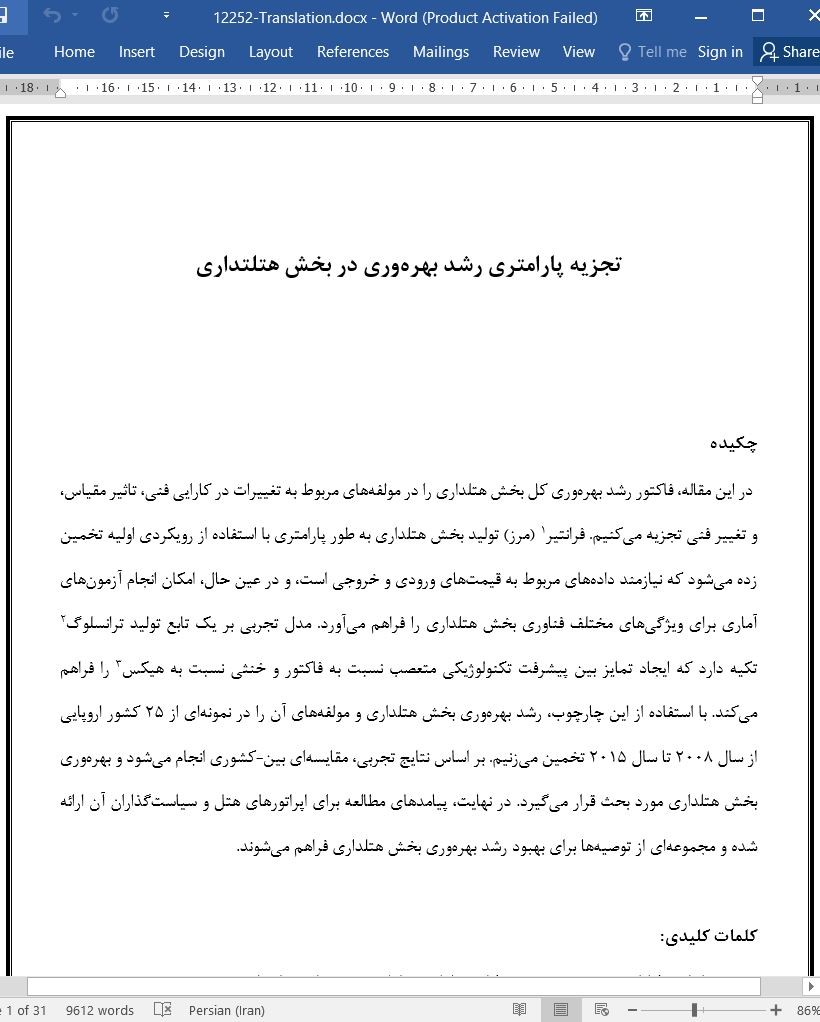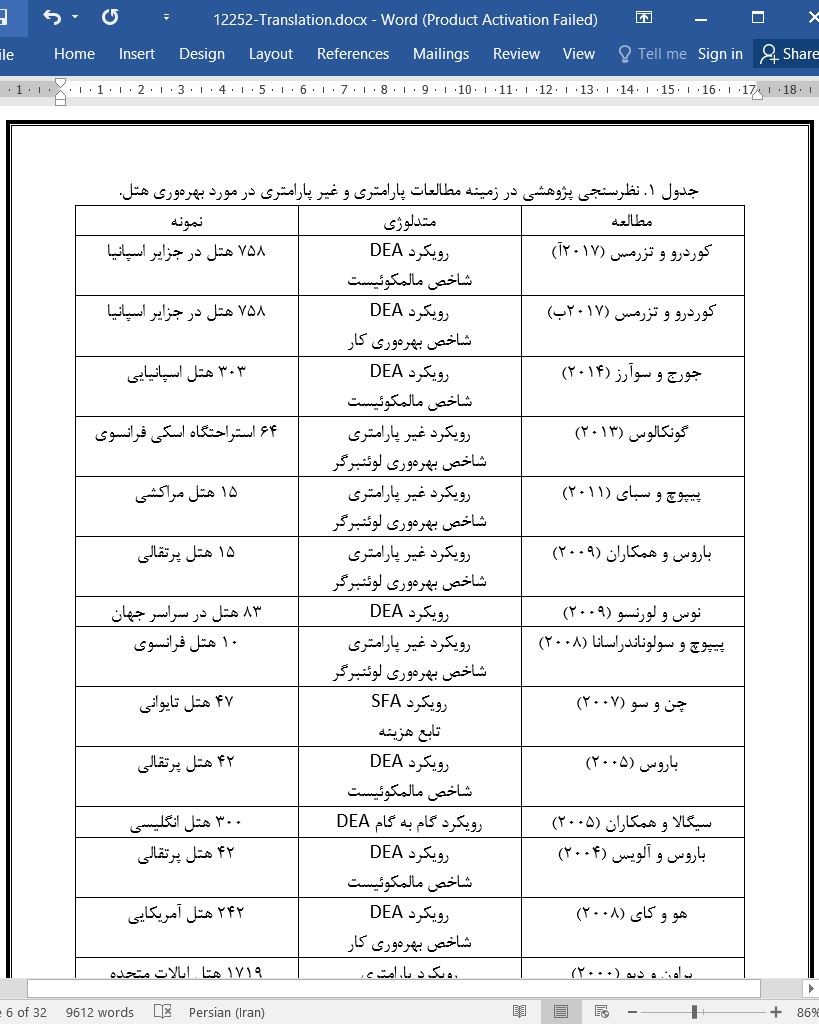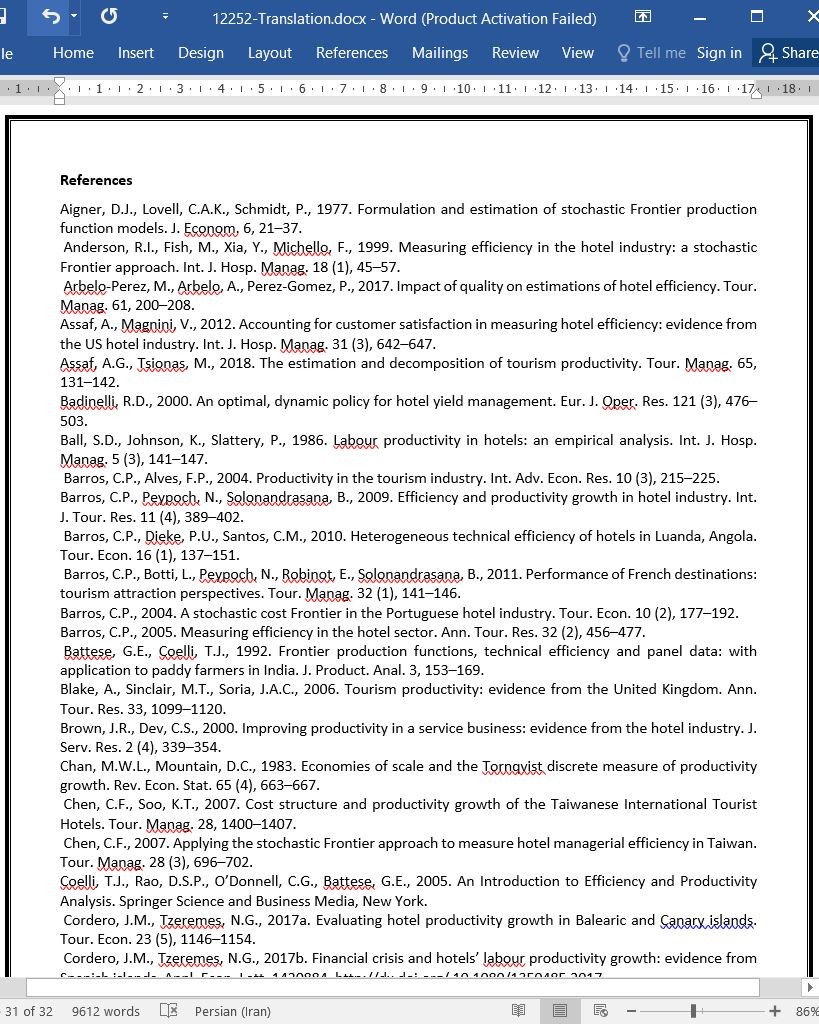
تجزیه پارامتری رشد بهرهوری در بخش هتلتداری
چکیده
در این مقاله، فاکتور رشد بهرهوری کل بخش هتلداری را در مولفههای مربوط به تغییرات در کارایی فنی، تاثیر مقیاس، و تغییر فنی تجزیه میکنیم. فرانتیر (مرز) تولید بخش هتلداری به طور پارامتری با استفاده از رویکردی اولیه تخمین زده میشود که نیازمند دادههای مربوط به قیمتهای ورودی و خروجی است، و در عین حال، امکان انجام آزمونهای آماری برای ویژگیهای مختلف فناوری بخش هتلداری را فراهم میآورد. مدل تجربی بر یک تابع تولید ترانسلوگ تکیه دارد که ایجاد تمایز بین پیشرفت تکنولوژیکی متعصب نسبت به فاکتور و خنثی نسبت به هیکس را فراهم میکند. با استفاده از این چارچوب، رشد بهرهوری بخش هتلداری و مولفههای آن را در نمونهای از 25 کشور اروپایی از سال 2008 تا سال 2015 تخمین میزنیم. بر اساس نتایج تجربی، مقایسهای بین-کشوری انجام میشود و بهرهوری بخش هتلداری مورد بحث قرار میگیرد. در نهایت، پیامدهای مطالعه برای اپراتورهای هتل و سیاستگذاران آن ارائه شده و مجموعهای از توصیهها برای بهبود رشد بهرهوری بخش هتلداری فراهم میشوند.
1. پیشگفتار
با بخش خدمات که بزرگترین عامل موثر در GDP در اروپا است و شکاف بهرهوری بین بخش خدمات و اقتصاد کلی که به طور پیوسته در سالهای اخیر افزایش یافته است (ون در مارل و همکاران، 2016؛ ون در مارل، 2017)، مسائل مربوط به بهرهوری خدمات وارد بحثهای عمومی و خطمشی در اتحادیه اروپا شدهاند (کمیسیون اروپا، 2016؛ بانک جهانی، 2016). در میان بخشهای مختلف خدمات، هتلداری اغلب نقش مهمی در بحثهای مربوط به نحوه افزایش مزایای اقتصادی از این صنعت خاص دارد، همچنان که این صنعت، منبع نیرومندی از درامدها و اشتغال داخلی را برای بسیاری از کشورهای اروپایی تشکیل میدهد. این علاقه به عملکرد صنعت هتلداری عمدتا ناشی از این چشمانداز به طور گشترده پذیرفته شده است که میزان بهرهوری بخش هتلداری، در مقایسه با سایر بخشهای اقتصاد، نسبتا پایین بوده است (ویت و ویت، 1989؛ جانز و ویلر، 1991؛ سیگالا و همکاران، 2005)، و بنابراین، امید برای رشد سریع بسیار بالا است. با توجه به این دیدگاه، سازمان جهانی گردشگری، به تازگی، در اقدامی برای جذب توجه محققان و افزایش اقدامات واکنشی از سوی سیاستگذاران و اپراتورهای هتل، مسائل مربوط به بهرهوری گردشگری را در رأس دستور کار پژوهشی قرار داده است.
Abstract
In this paper, we decompose hotel-sector total factor productivity growth into components attributable to changes in technical efficiency, scale effect, and technical change. The hotel-sector production Frontier is approximated parametrically using a primal approach requiring no data on output and input prices while permitting the conduction of statistical tests for the various features of the hotel-sector technology. Our empirical model relies on a flexible translog production function which allows to distinguish between Hicks-neutral and factor-biased technological progress. Using this framework, we estimate hotel-sector productivity growth and its components in a sample of 25 European countries from 2008 to 2015. Based on the empirical results, a cross-country comparison is performed and the sources of hotel-sector productivity are discussed. Finally, the implications of the study for hotel operators and policy makers are presented and a set of recommendations is developed for improving hotel sector productivity growth.
1. Introduction
With the service sector being the largest contributor to GDP in Europe and the productivity gap between the service-sector and the overall economy constantly increasing in the last years (Van Der Marel et al., 2016; Van Der Marel, 2017), service productivity issues have come to the fore of public and policy discussions within EU (European Commission, 2016; World Bank, 2016). Among the various service sectors, hospitality often takes a central role in controversies over how to raise the economic benefits from this specific industry which constitutes a robust source of revenues and domestic employment for many European countries. This interest on the performance of the hospitality industry has been mainly motivated from the broadly accepted view that hotel-sector productivity rates have been relatively low compared with other sectors of the economy (Witt and Witt, 1989; Johns and Wheeler, 1991; Sigala et al., 2005), and therefore the prospects for a rapid growth there might be extremely high. Driven from this view, World Tourism Organization recently placed productivity issues in tourism at the top of the research agenda in an effort to attract attention from researchers and enhance response actions from policymakers and hotel operators.
چکیده
1. پیشگفتار
2. چارچوب نظری
3. دادهها و مدل اقتصادسنجی
3.1. دادهها
3.2. مدل اقتصادسنجی
4. نتایج
5. نتیجهگیریها و مفاهیم
منابع
ABSTRACT
1. Introduction
2. Theoretical framework
3. Data and econometric model
3.1. Data
3.2. Econometric model
4. Results
5. Conclusions and implications
References
- اصل مقاله انگلیسی با فرمت ورد (word) با قابلیت ویرایش
- ترجمه فارسی مقاله با فرمت ورد (word) با قابلیت ویرایش، بدون آرم سایت ای ترجمه
- ترجمه فارسی مقاله با فرمت pdf، بدون آرم سایت ای ترجمه



